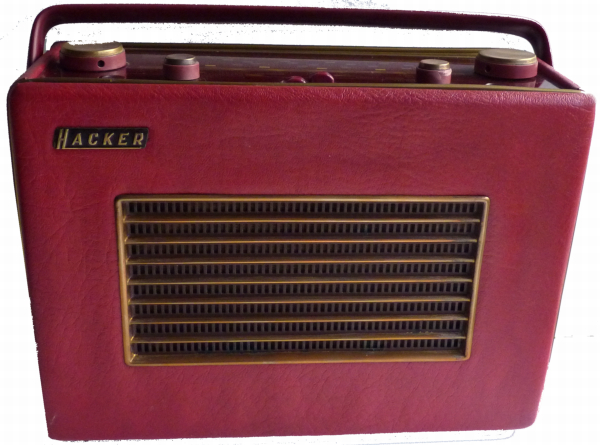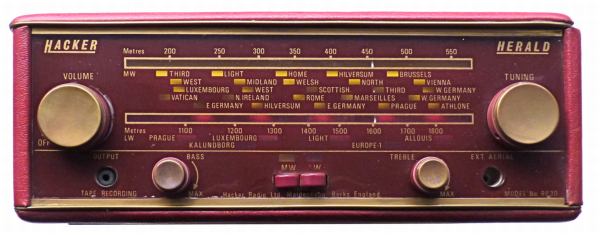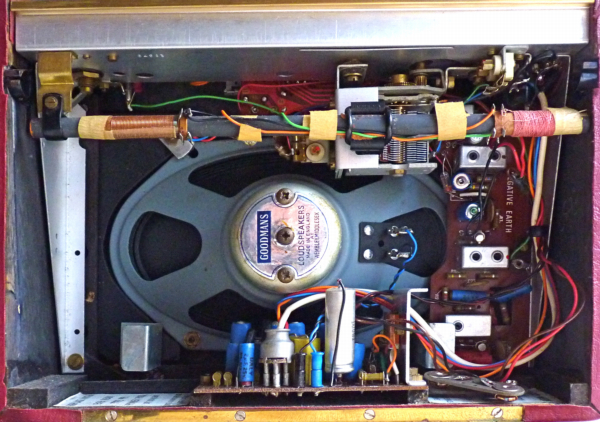
Serial number 54563

Portable nine Transistor radio A long/medium waveband radio
Made by Hacker Radio Ltd, Maidenhead UK. The radio which was kindly
given to me by Angela Cave in
2009 is housed in a red leatherette covered wooden case with gold trim
to loudspeaker and knobs.
This radio is normally powered by two 9 volt PP9 batteries as is common
for most of the Hacker range. This model was first produced in 1964 and
RP30 Herald. LW/MW. It is smaller than the RP18
and electrically similar except that FM circuits are omitted. It was
available in black, blue or red. The blue versions may have grey or
white knobs, pushbuttons and rear grille.
When I received this radio it was silent, though I soon established
that the amplifier worked by swapping it with that in RP18 although the
output seemed distorted. I discovered that the the 500uF electrolytic
capacitor feeding the loudspeaker had deteriorated and it was replaced.
After cleaning the wave change pushbutton contacts the set produced
weak
signals on both long and medium wave but not for long!
I
suspected that transistor TR3 (AF117) might be the culprit so snipped
the screen lead. I still found that the set seemed to work erratically
and when the bunch of wires to the amplifier and batteries were
disturbed the set would cut out. Eventually I discovered that one pole
of the switch on the volume control was making intermittent contact and
despite cutting the screen on the transistor I had not solved the "tin
whisker" problem. A very sharp blow to TR3 dramatically increased the
output from the speaker, so another replacement was required (someone
had previously replaced TR2 with an AC127). I did not have one of these
but I found that a TI GM1213B did the trick. This is a silicon PNP
transistor without a screen connection rather than the original
germanium type.

View of dial and controls

Inside view
Stewart Kitch has sent me the following information about his career at Airmec which sheds an interesting light upon the manufacture of some Hacker radios.
I moved back to Somerset to work at Airmec at Seaton Devon, firstly as a "test improver". While "improving" I worked on valve test equipment such as their Signal generator 210 and wave analyzer 853, prior to a Racal take-over in about 1969. I then calibrated and repaired the test equipment, and saw some examples of this on your web site. At this time we also had a contract to build and test Hacker radios, such as the Herald, and I remember building a stereo record player using 2 of audio amps! We had 2 Test personnel; I tested all the instruments and the other guy did the Hacker Radios. As Racal expanded I ran a section that tested a range of "Racal Instruments" products which were largely frequency counters. Several other Racal companies ran our site, with more profit being made on military radios such as the 931X. I think I could still test one of those in my sleep!
Cellular radio then reared its head and we made the car "transportable" model, before making a few "almost portable" models. These were fairly troublesome, but Racal made a good profit and started Racal-Vodafone as it was then. We later made the most complicated 39D military radio and were waiting for the Bowman project which was eventually awarded to another company. Following rumours of a take-over by Thompson CSF, we were closed in 2000 and all made redundant, the factory being demolished a few weeks ago. Racal became Thales, but Vodafone continues.
I believe Airmec opened their second factory at Seaton in 1965 to make use of our cheaper labour! The "Banbury" was the first building, made of concrete panels and located on the site of the Southern Railway station which was not demolished until later (1969?) High Wycome remained the Head office and were always keen to tell us where we were going wrong! During a holiday last year, another couple joined us at our table who hailed from Wycombe. I told her of Airmec and she said she worked there after leaving school as a typist, and knew several of the directors and staff including Fred Pears, who was in charge of Seaton. She started in the late 50's and left when her family arrived.
Besides the Hacker contract there was also a Motorola contract for car radio sub assemblies, which ceased soon after I arrived. Another "flop" was "Telefi", a small box which picked up the sound from your TV IF to feed into your Hi -fi for much better sound. They were constructed in nice wooden boxes - I still have loads of small wood screws that were used!
Thinking hard, I believe we made 2 models of Hacker Radios, but although one looked like the Herald, I'm sure that was not the name. It was a long time ago though.
B Wixon who worked for Airmec for 8 years until the merger with Racal Instruments for whom he worked for a further 3 years was interested to see that they later went on to test both Racal and Hacker products, presumably after the Airmec range was phased out. After starting in the Test Dept he transferred to the Service Dept eventually becoming Service Manager. He goes on to say that Airmec opened the Seaton factory to take advantage of a government scheme to take employment to such areas as the South West. Plans were made to transfer some of the staff from High Wycombe, but were probably shelved when the merger was mooted. He was also invited by Fred Pears to take over the running of the Test Dept there but declined after visiting the area. He says that Stewart Kitch was correct in that they did make several suggestions to them particularly with regard to testing, as they had more experience. Part of his job was to carry out pre-sales tests on the equipments from which some problems were found and he feels sure "they would have benefited from our experience".

